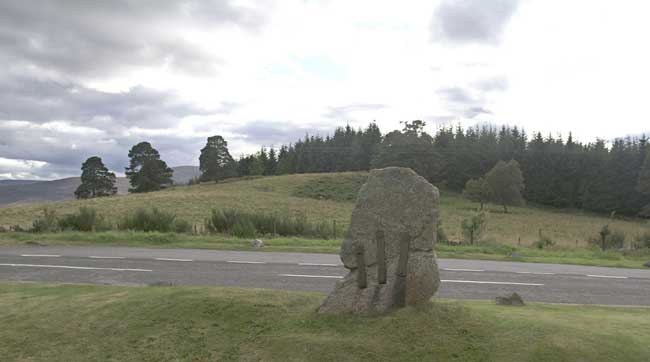Location
Above Finzean on B 976 road to Ballogie and Potarch. Formerly on SW side of road which has been re-aligned on 1:10,000 map (1982) The stone now stands on the NE side of the road.
Finzean, Aboyne
OS Map Reference
NO 596 939
Date
Unknown
Description
A squarish block of reddish granite, about 4'7" in maximum height and 7' in girth, which was dug up many years before 1842 and was erected on top of the hill of Corsedardar, in the belief that it had marked the grave of some eminent person. The stone has been split, and now has the two portions set into a bed of concrete and pieced together by strong iron bands. Tradition says that it marks the spot where Dardanus, a Pictish king, was killed. A stone, 1.5m high, 0.8m wide, and 0.2m thick, generally as described, and possibly a cist slab. Visited by OS (R L) 12 June 1972. from RCAHMS
Related Information
This story would seem to be folk history of a made up kind, the name Dardanus originates from Greek myth (the son of Zeus and Electra,) and is nothing like any Pictish name from the 'Pictish King Lists' or other extant historical sources. A king of this name is mentioned in Hector Boece's (or Hector Boyce) History of Scotland, published in 1527 under the title Scotorum Historiae a prima geniis origine cum aliarum et rerum et gentium illustratione non vulgari. By modern standards not an accurate source for information on the Pictish period. The place name Corsedarder means 'the hill of Darder' the name and the stone are both likely to be older than the period of Boyce's Dardanus.
Nearby is a bronze age burial long cairn traditionally assumed to be the burial place of said Dardanus. In the background of the photograph is the local War Memorial for the parish of Birse built by William Kelly c 1920 see related artefacts for both.
The stone was found in the 18th century and erected on site.
During some road works in the 19th century the stone was dropped and broken. The local laird (Farquharson, Finzean estate) had the stone fixed with metal bands and put back in position.
Era
Disputed
Information Source
RCAHMS http://www.rcahms.gov.uk/
Related Artefacts
Categories
Photographer
- Jim Henderson
Unavailable Data
- Iconography
- Creator
- External Links
This content was submitted by external contributors and does not necessarily reflect the views of the University of Aberdeen.


